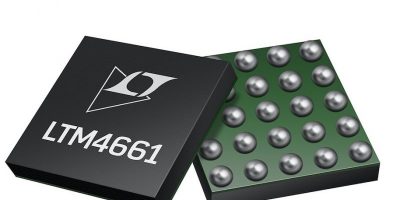Boost regulator from Analog Devices is for low voltage optical systems
Combining a small, thin package and wide input and output voltage range, the LTM4661 is suitable for a range of applications including optical modules, battery-powered equipment, battery-based back-up systems, bias voltage for power amps or laser diodes and small DC motors, says Analog Devices.
The Power by Linear LTM4661 low power step-up µModule regulator is available in a 6.25 x 6.25 x 2.42mm BGA package. According to Analog Devices, only a few capacitors and one resistor are required to complete the design which occupies less than 10mm² single-sided or 5mm² on double-sided PCBs.
The LTM4661 incorporates a switching DC/DC controller, MOSFETs, inductors and supporting components. It operates from a 1.8 to 5.5V input supply, and continues to operate down to 0.7V after start-up. The output voltage can be set by a single resistor ranging from 2.5 to 15V.
The LTM4661 can deliver 4.0A continuously under 3.3Vin to 5Vout, and 0.7A continuously under 3.3Vin to 12Vout. The LTM4661 employs synchronous rectification, which delivers up to 92 per cent conversion efficiency (3.3Vin to 5Vout). The switching frequency is 1.0MHz, and can also be synchronised to an external clock ranging from 500kHz to 1.5MHz. The 1.0MHz switching frequency and dual phase single output architecture enable fast transient response to line and load changes and a significant reduction of output ripple voltage, says Analog Devices.
The LTM4661 has three operation modes, Burst Mode operation, forced continuous mode and external sync mode. The quiescent current in Burst Mode operation is only 25-microA, which provides extended battery runtime. For applications demanding the lowest possible noise operation, the forced continuous mode or external sync mode minimise possible interference of switching noise.
The LTM4661 features an output disconnect during shutdown and inrush current limit at start-up. There is also short-circuit, over-voltage and over-temperature protection.
The LTM4661 operates from –40 to +125 degree C operating temperature.




